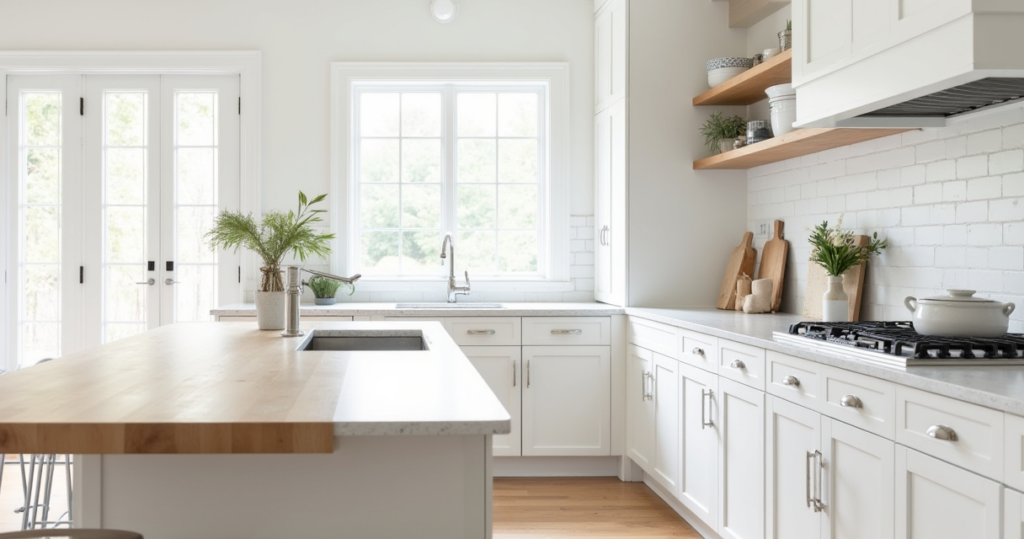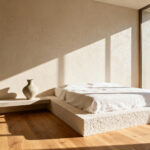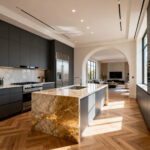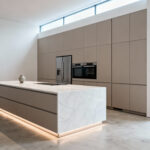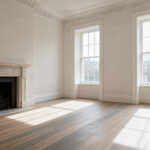Can we please talk about why so many people get the white kitchen wrong? Everyone seems to think it’s the “safe” choice, the default you pick when you can’t decide. They see a blank space and think the work is done. But to me, that’s where the work—and the real joy—begins. A white kitchen isn’t a destination; it’s a starting point. It’s the pristine, hand-stretched canvas an artist receives before creating a masterpiece. It’s the quiet before the music starts.
When clients come to me worried that a white kitchen will feel sterile or bland, I see it as a beautiful misunderstanding. I grew up navigating the textures and traditions of two distinct cultures—the hearty, resilient woods of Polish farmhouses and the delicate, symbolic artistry of Chinese porcelain. What I learned is that harmony isn’t about matching everything; it’s about balancing energies. And a white kitchen is the perfect stage for that balance. It’s a backdrop that asks, “Who are you? Where have you been? What stories do you want to tell?” It doesn’t shout; it listens. And it lets every other element in the room—every texture, every piece of your history—sing.
Foundational Design & Planning Strategies (Part 1)
Before you pick a single cabinet or tile, you have to think about the spirit of your kitchen. This isn’t just noise; it’s the most critical part. Planning is about defining the room’s philosophy, its energy, its emotional temperature. Get this right, and everything else falls into place with a sense of rightness you can feel in your bones.
1. Define Your Signature White Kitchen Aesthetic (Modern, Classic, Farmhouse)
Let’s be clear: “white kitchen” is not an aesthetic. It’s a color choice. The real work is deciding on the story you want the space to tell. Are you aiming for the clean, uncluttered peace of a minimalist Japanese tea room (Modern)? The enduring, layered history of a Warsaw Old Town apartment (Classic)? Or the grounded, earthy honesty of a Polish country cottage (Farmhouse)? Choosing your direction isn’t about limiting yourself; it’s about giving yourself a powerful filter for every decision that follows.
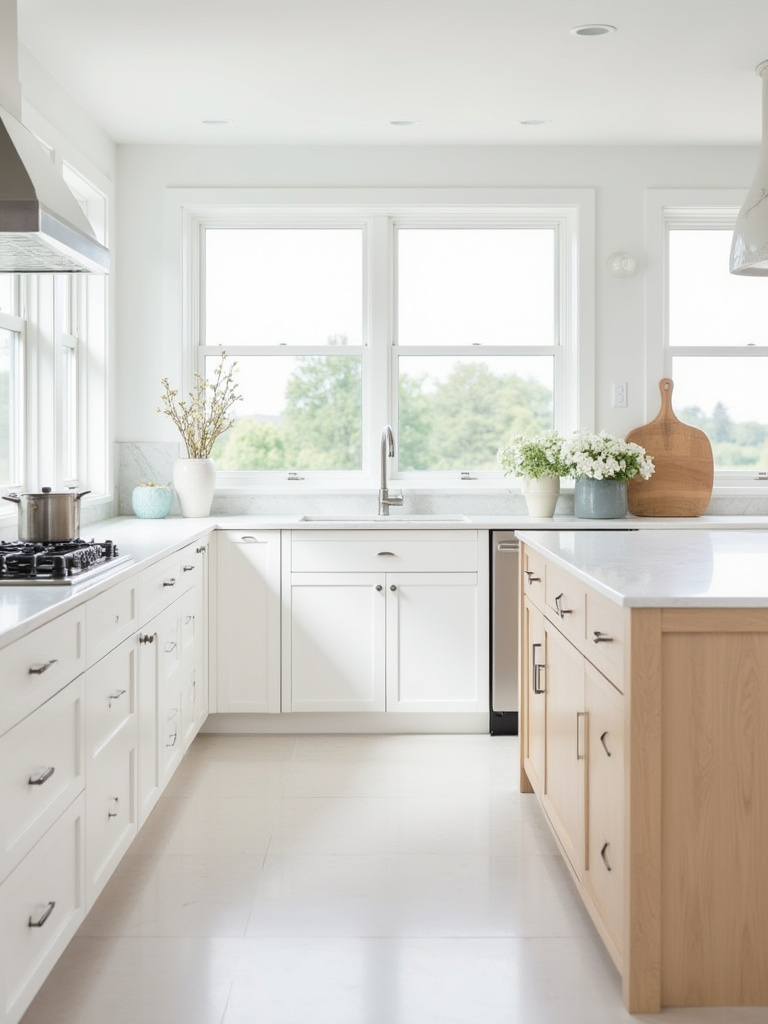
Without this North Star, you end up with a collection of nice white things that have nothing to say to each other. A client once brought me a mood board with sleek German cabinets, a rustic French range, and ornate Italian hardware. Separately, they were lovely. Together, they were shouting at each other in three different languages. We had to pause and ask the fundamental question: what is the feeling we want to create here? Once we landed on “serene and collected,” the choices became instantly clear.
With that guiding principle, we can move on to the physical flow of the space.
2. Optimize Kitchen Layout for Seamless Workflow and Entertaining
You can have the most beautiful kitchen in the world, but if you’re constantly bumping into people or trekking a mile between the fridge and the stove, you’ll grow to resent it. In Chinese culture, we think a lot about the flow of energy, or qi. A good layout isn’t just about efficiency; it’s about creating a harmonious flow where cooking feels like a dance, not a battle. The classic “work triangle” is a good start, but I encourage you to think more about “zones.”
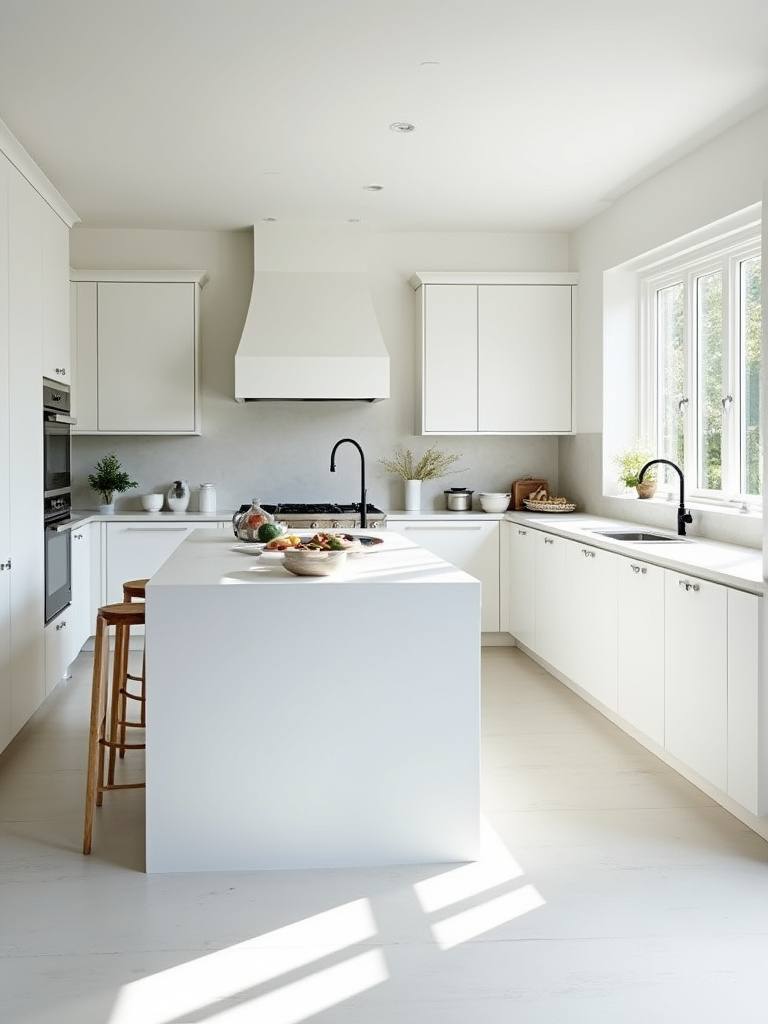
Think about your daily rituals. There’s a zone for making your morning coffee, a zone for chopping vegetables, a zone for cleanup, and maybe even a zone where guests can perch with a glass of wine without getting in your way. A well-designed layout choreographs these movements so they feel intuitive and graceful. I learned this the hard way in my first tiny apartment, where the refrigerator door blocked the main path when it was open. It created a daily bottleneck of frustration—bad energy, plain and simple. Now, I map out every step with my clients before we commit to a single cabinet.
Once the layout feels right, we can get into the nuance of the main color itself.
3. Select the Perfect Shade of White to Reflect Your Desired Mood
The biggest misconception is that white is just white. It’s not. There are hundreds of whites, each with its own subtle energy and personality. Choosing the right one is like tuning an instrument. A crisp, cool white with blue undertones feels modern, architectural, and gallery-like. A creamy, warm white with yellow or beige undertones feels welcoming, traditional, and gentle, like aged linen. A balanced, neutral white is like a perfect host—gracious and accommodating to any style you bring in.
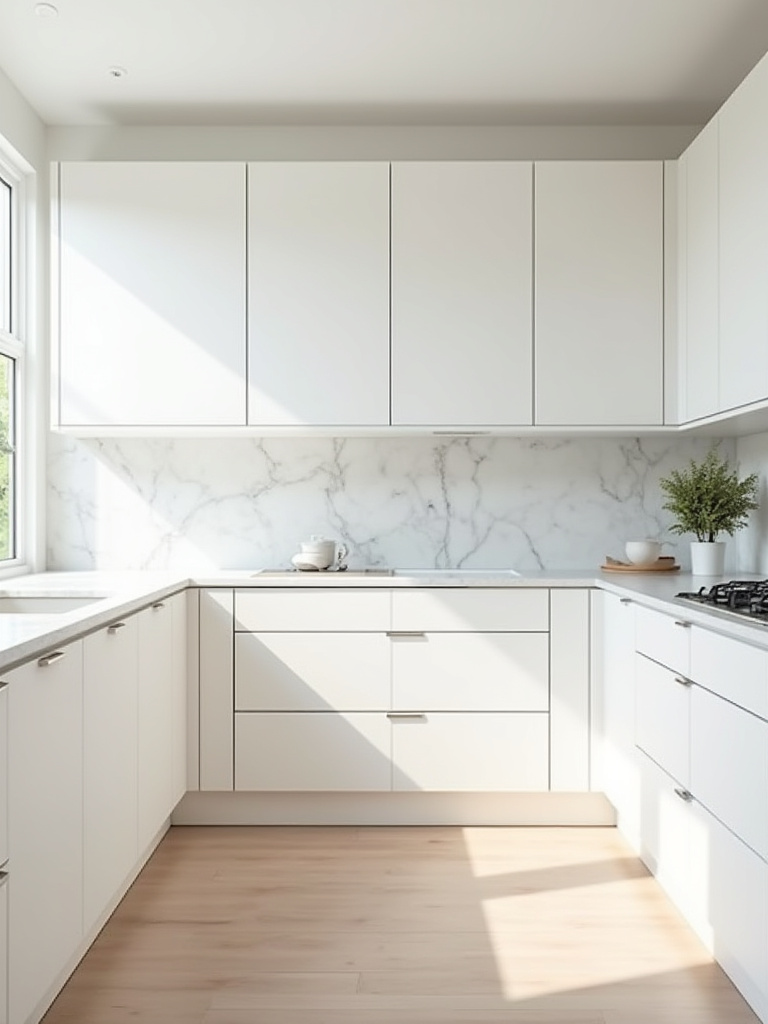
A client in a city with long, grey winters desperately wanted a bright kitchen, so she initially chose the starkest, purest white available. But in her north-facing room, it just ended up feeling cold and clinical. We switched to a slightly warmer white—Benjamin Moore’s White Dove—and the entire room exhaled. It still felt bright and clean, but now it had a soul. The shortcut I wish I’d known earlier? Paint large sample boards and move them around the room for a few days. See how the color speaks to the light at dawn, at noon, and in the evening.
This brings us to the most powerful element in a white kitchen: light itself.
4. Maximize Natural Light with Strategic Window Placement and Reflective Surfaces
A white kitchen is a master of light. It grabs every available sunbeam and bounces it around, making the space feel expansive and alive. This isn’t just about putting in a big window over the sink. It’s about thinking how light travels through your home and how you can amplify it. Can you add a transom window above a doorway? Can you use a backsplash with a subtle gloss that reflects the light from an adjacent room?
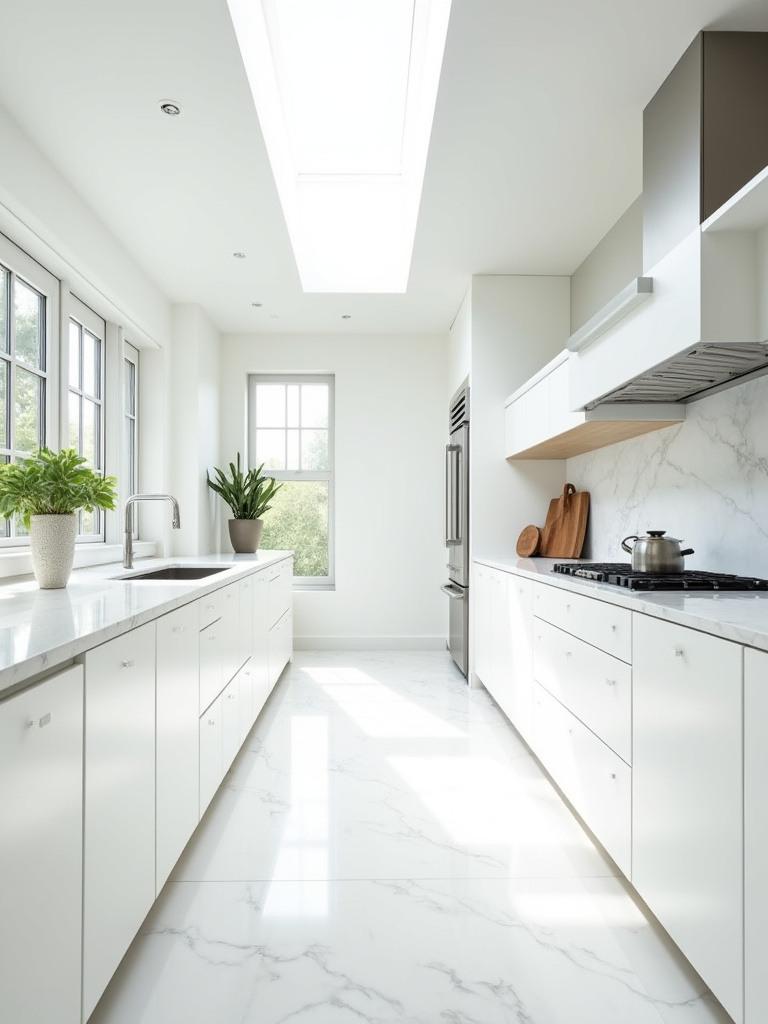
I often draw from the Polish tradition of the dworek (manor house), where rooms were designed to capture the sun’s path throughout the day. In your kitchen, this means pairing your light-maximizing efforts with reflective surfaces. Think a polished stone countertop, high-gloss cabinets (if that’s your style), or even the sheen on your metallic hardware. These elements become partners with the sun, working together to create a space that feels bright and optimistic, even on a cloudy day.
Now that we have the room’s energy and light set, we can talk about the materials that will live within it.
Foundational Design & Planning Strategies (Part 2)
Here, we layer in the materials that will give our white canvas its unique voice. Think of this as choosing the texture of your paint and the type of brush you’ll use. It’s all in the details that create a cohesive, touchable world.
5. Establish a Harmonious Material Palette to Complement White Cabinets
Your white cabinets are the lead singer, but they need a brilliant band to back them up. The material palette—your countertops, flooring, backsplash, and hardware—is that band. The goal is harmony, not uniformity. You need contrast and texture to create depth and keep the eye engaged. Too much of the same smooth, white surface, and you’re back in that sterile, soulless space we’re trying to avoid.
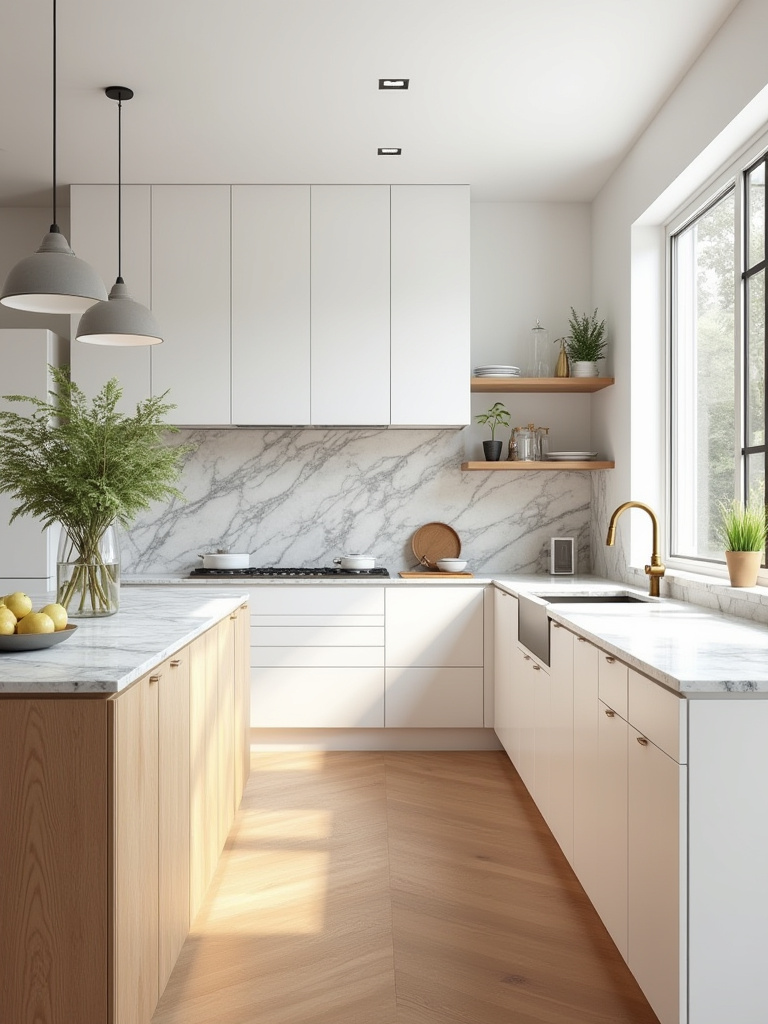
I guide my clients to choose a primary “grounding” material first. Often, this is a beautiful Natural wood or a stone with unique veining. For one multicultural family, we chose a rich walnut for the island base—it felt sturdy and rooted, reminiscent of the forests in my client’s Polish homeland. From there, we layered in a quiet, honed quartz countertop and a handmade zellige tile backsplash whose subtle imperfections caught the light beautifully, adding a touch of my other client’s Moroccan heritage. These materials didn’t just look good; they told the story of their family.
With our palette defined, we can dive deeper into each of these core components.
Core Elements: Selecting & Integrating Key Components (Part 1)
This is the nitty-gritty—the essential building blocks of your kitchen. We’re moving from the philosophical to the tangible. Each choice here affects not only how your kitchen looks, but how it feels to touch, how it endures daily life, and how effortlessly it functions.
6. Choose Durable White Cabinet Finishes for Longevity and Easy Maintenance
This is where practicality meets beauty. You can create the most stunning kitchen, but if your white cabinets yellow, chip, or stain within a few years, the dream dies quickly. The finish is everything. It’s the protective shield that will stand up to splattering sauces, greasy fingers, and the relentless march of time. Don’t let anyone tell you this is a place to cut costs.
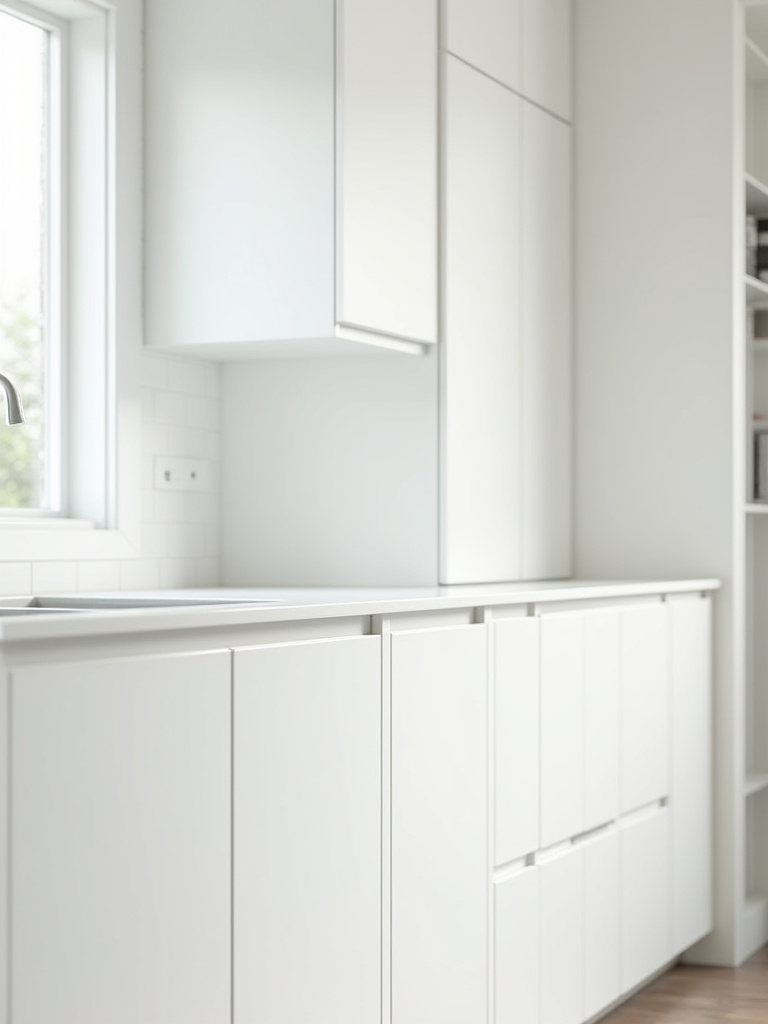
The corporate speak will throw terms like “thermofoil” and “catalyzed lacquer” at you. Here’s the real story: You want a factory-applied finish that’s been cured for hardness. This is far more durable than anything that can be painted on-site. Think of it like the glaze on a piece of high-fired porcelain—it’s bonded to the material. I tell my clients to ask for samples and then abuse them. Put some coffee on it, a little red wine, a dab of mustard. Leave it overnight. See what happens. The one that wipes clean without a trace is your winner.
Now for the surface you’ll interact with every single day.
7. Install Eye-Catching Countertops to Add Texture and Visual Interest
If the cabinets are the canvas, the countertops are the main subject of the painting. This is your chance to make a statement and introduce a powerful sense of character. An all-white kitchen with a plain white counter can fall flat. But add a slab of stone with dramatic veining, a warm block of butcher wood, or a sleek sweep of dark soapstone, and suddenly, the room has a heart.
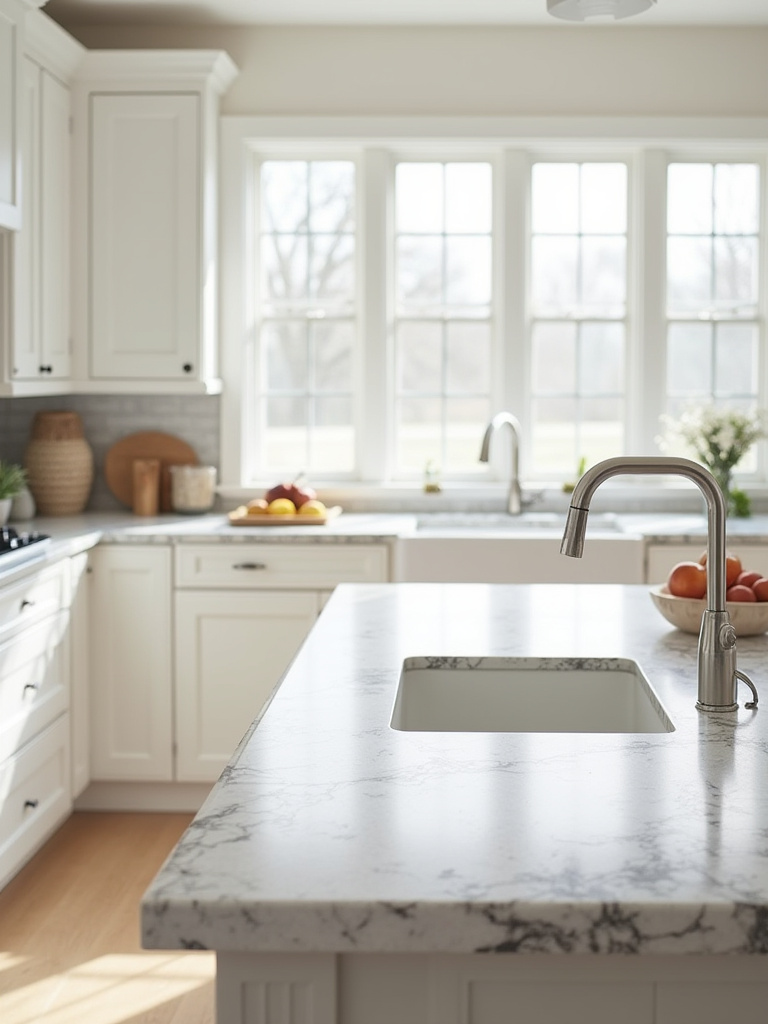
Remember, texture is just as important as color. I once had a client who was set on white marble but was worried about the maintenance. We found a stunning quartzite with similar movement and a honed—not polished—finish. The soft, matte texture was incredible to the touch and didn’t show every single fingerprint. It brought a quiet, natural elegance to her modern white kitchen that felt both ancient and new. That’s the goal: to find a material that not only looks beautiful but also adds a sensory experience.
Let’s look down and consider the foundation of the room.
8. Incorporate Flooring Materials that Enhance and Balance the White Scheme
The floor is what grounds your entire design. In a bright, airy white kitchen, the flooring can provide a much-needed anchor, preventing the space from feeling like it might float away. Choosing a very light or white floor can sometimes create a “white-out” effect where it’s hard to distinguish where the cabinets end and the floor begins. This is where contrast can be your best friend.
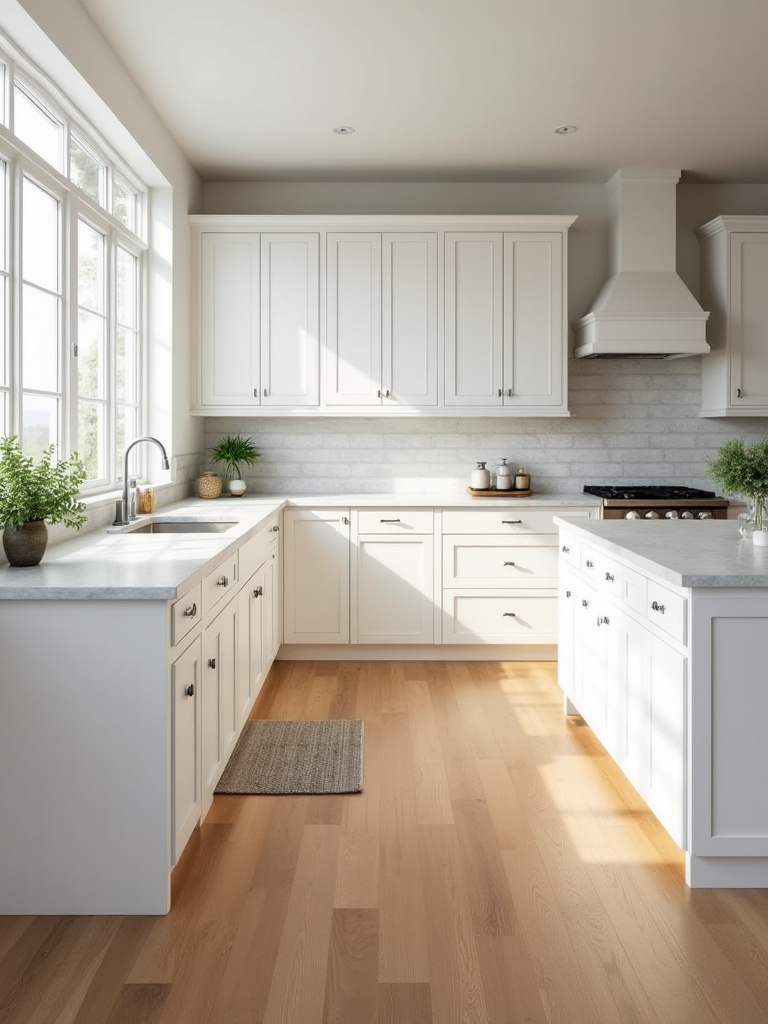
A warm wood floor is a classic for a reason—it brings immediate warmth and life. In my own home, I chose a medium-toned oak, reminiscent of the floors in my babcia’s house, laid in a herringbone pattern for a touch of classic European elegance. But wood isn’t the only answer. A beautiful slate, a patterned cement tile, or even a large-format porcelain that mimics concrete can provide a beautiful, textural contrast that makes your white cabinets pop. The floor is the earth to the sky of your white ceiling.
Before we fill those beautiful cabinets, we have to think about what goes inside them.
9. Integrate Smart Storage Solutions Within White Cabinetry for Clutter-Free Spaces
A white kitchen is a celebration of clarity and open space. And nothing kills that vibe faster than clutter. Blenders, toasters, spice jars, and utensils all vying for space on the counter create visual chaos. True luxury, to me, is not about having more things, but about having a perfectly organized place for everything. This is where smart storage becomes a non-negotiable part of the design.
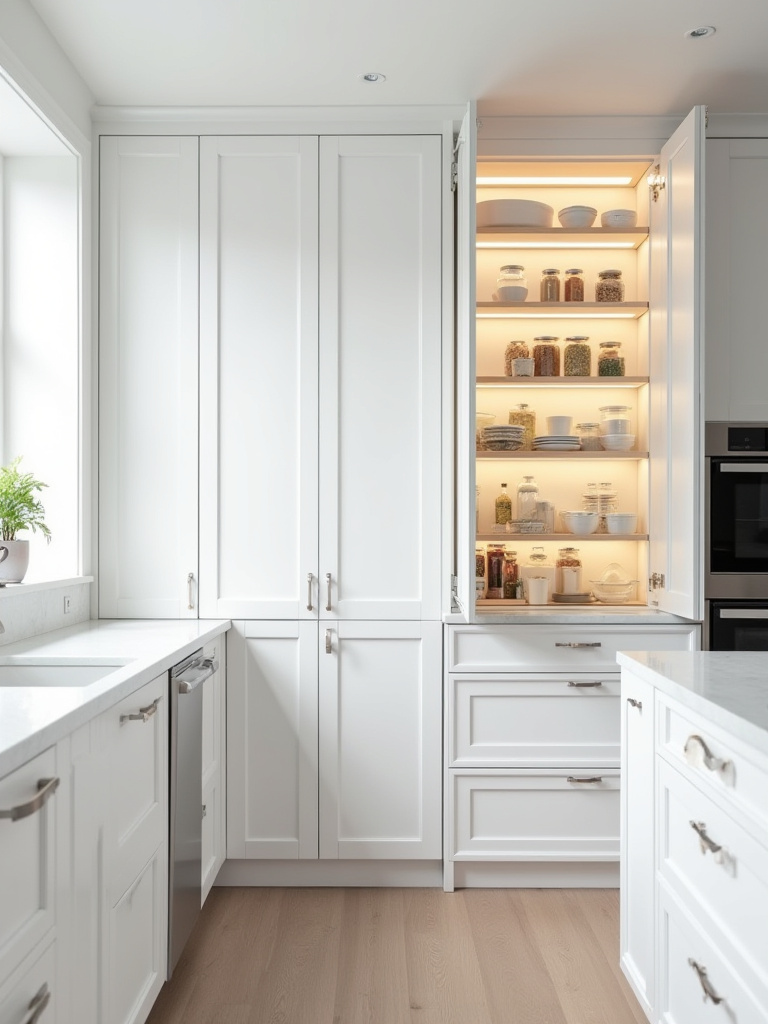
Forget just having shelves. We’re talking about pull-out pantries, corner lazy Susans, drawer dividers for spices and utensils, and dedicated appliance garages with outlets inside. By designing the storage around your specific items and workflow, you create a kitchen that feels effortlessly calm and clean. My confession: I used to think this was just a nice add-on. Then I designed a kitchen with a custom drawer for my wok, bamboo steamer, and cleaver. Having these tools exactly where I needed them, perfectly organized, transformed my cooking experience. It’s about creating inner peace by eliminating outer chaos.
With the core structure in place, let’s talk about the engines and the stars of the show.
Core Elements: Selecting & Integrating Key Components (Part 2)
This section is about the functional workhorses—appliances and lighting. But just because they have a job to do doesn’t mean they can’t be beautiful. Here, we integrate them so they feel like a natural part of the overall design symphony, either by blending in quietly or by becoming a stunning focal point.
10. Select Appliances that Blend Seamlessly or Provide Sophisticated Contrast
Your appliances are a major design choice. You have two primary paths: seamless integration or intentional contrast. Integration, using panel-ready appliances hidden behind fronts that match your cabinetry, creates a supremely calm and cohesive look. It’s a very European approach that makes the kitchen feel less like a utility room and more like a beautifully furnished living space. This is perfect for minimalist aesthetics or open-concept homes where you want the kitchen to recede elegantly.
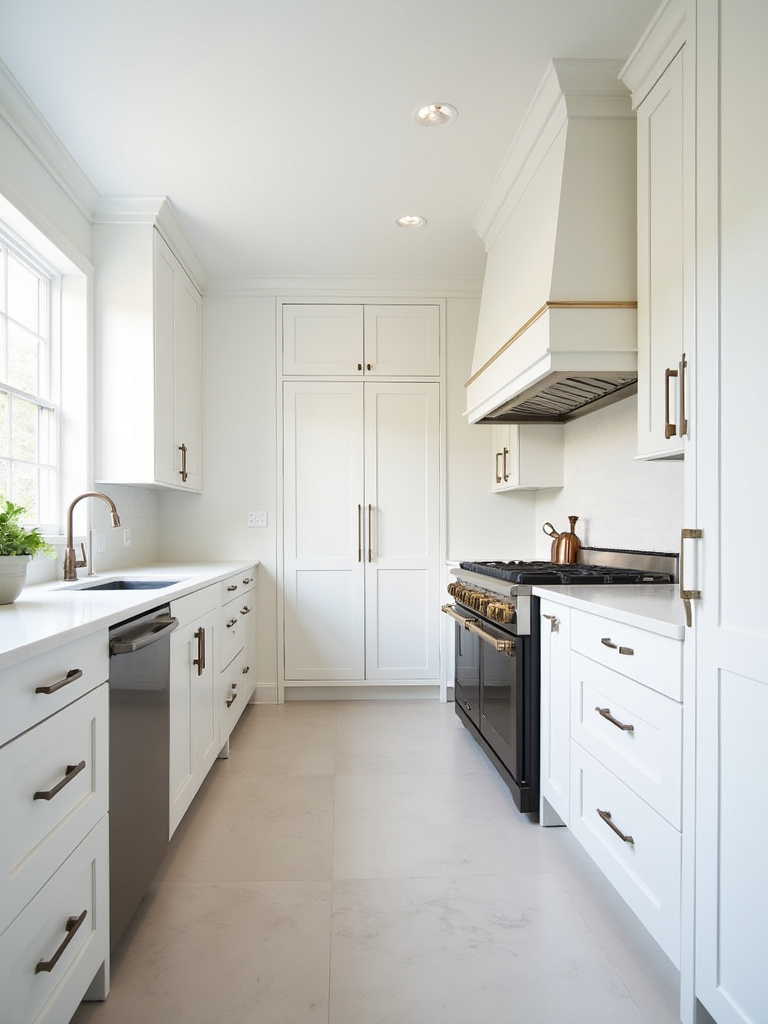
The other path is to make your appliances a feature. A bold, professional-grade range in matte black or brushed brass against a backdrop of white cabinets can be absolutely stunning. It becomes the anchor, the centerpiece. I once worked with a family who blended their heritages through their range—they chose a gorgeous French Lacanche range in a deep burgundy, a nod to their love of wine-making, which stood proudly in their classic white kitchen. It was a bold statement that told a story about their passions. There’s no wrong answer here, only an intentional one.
No matter your choice, how you light your kitchen will determine its ultimate success.
11. Design a Layered Lighting Scheme for Both Functionality and Ambiance
This is the one thing everyone gets wrong. They stick a single flush-mount fixture in the middle of the ceiling and call it a day. That is the fastest way to ruin a beautiful white kitchen. A white space demands layered lighting because a single, harsh overhead light will create unforgiving shadows and a sterile, flat feeling. You need three layers: Ambient, Task, and Accent.
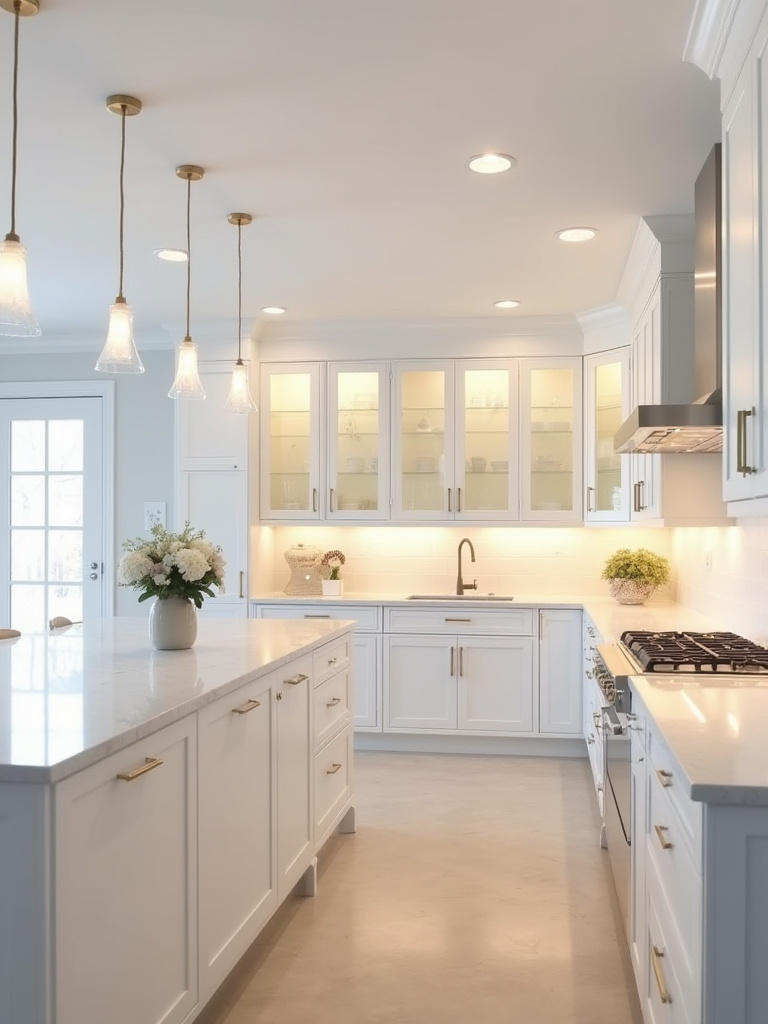
“Lighting is the unsung hero of any good design. In a white kitchen, it’s the difference between a sterile lab and a welcoming sanctuary.”
Ambient is your general, overall light (recessed cans are great for this). task lighting is your focused work light—think under-cabinet LEDs that illuminate your counters and pendants over an island. This is non-negotiable for safety and function. Finally, Accent lighting is the magic. It’s the soft light inside a glass cabinet showcasing your favorite ceramics, or a beautiful sconce on a wall that adds a warm glow. By putting each of these layers on a dimmer, you can instantly change the mood from bright and functional for cooking to soft and intimate for entertaining.
Now for the fun part: adding the layers of personality that make the space truly yours.
Styling & Enhancements: Elevating the White Canvas (Part 1)
This is where we infuse the space with warmth, soul, and story. A white kitchen provides the perfect, quiet backdrop for these elements to shine. It’s like dressing a classic white shirt—the accessories make all the difference.
12. Introduce Warmth and Character with Natural Wood Accents
Wood is the single most powerful tool for bringing warmth and life into a white kitchen. It introduces an organic, natural element that instantly makes a space feel more grounded and approachable. The BS everyone falls for is thinking it has to be a whole floor or a massive butcher block. Even small touches can have a huge impact.
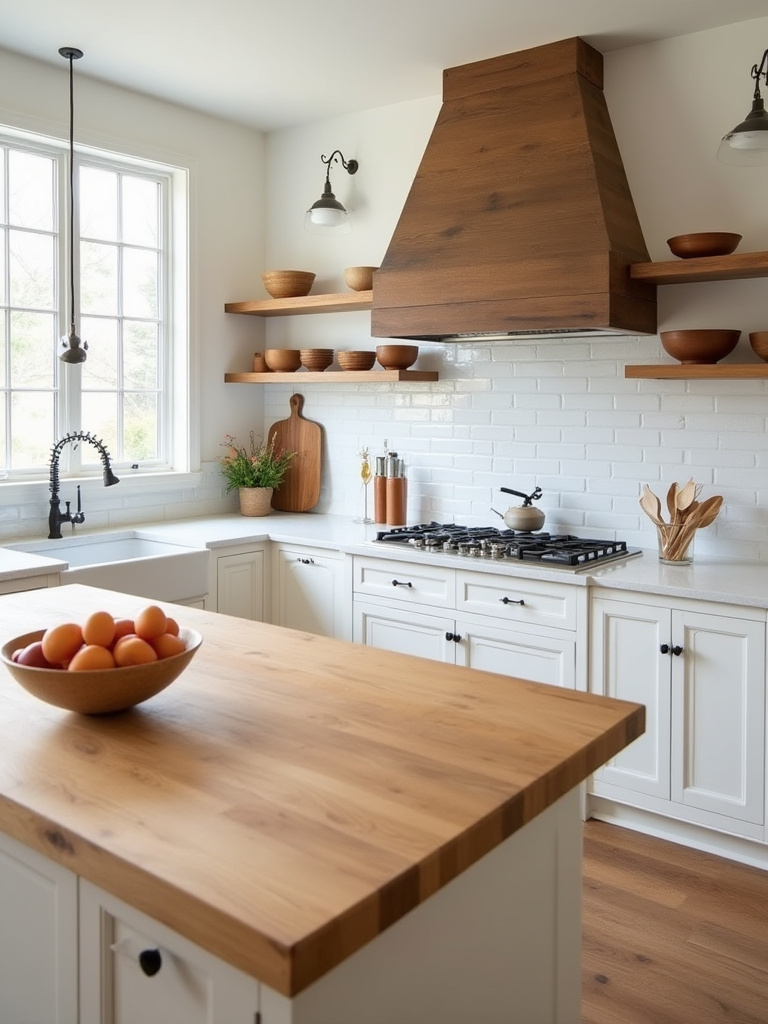
Think about open shelving made from reclaimed wood, a collection of beautiful wooden cutting boards leaning against the backsplash, or even the legs of your bar stools. In my own kitchen, I have a simple, oversized wooden bowl that my Polish grandfather carved. It sits on my white quartz island, and it’s more than just a fruit bowl; it’s a piece of my history. It provides texture, warmth, and a daily connection to my heritage. That’s the kind of power a simple wood accent can have.
Next, let’s build on that with more sensory details.
13. Layer Textures Through Textiles, Seating, and Decorative Elements
A room that only has smooth, hard surfaces feels lifeless. Texture invites touch and makes a space feel cozy and real. This is where you can have so much fun in a white kitchen, as even the subtlest textures stand out. Think about a nubby wool runner on the floor, the woven cane back of a bar stool, or the soft linen of a Roman shade on the window.
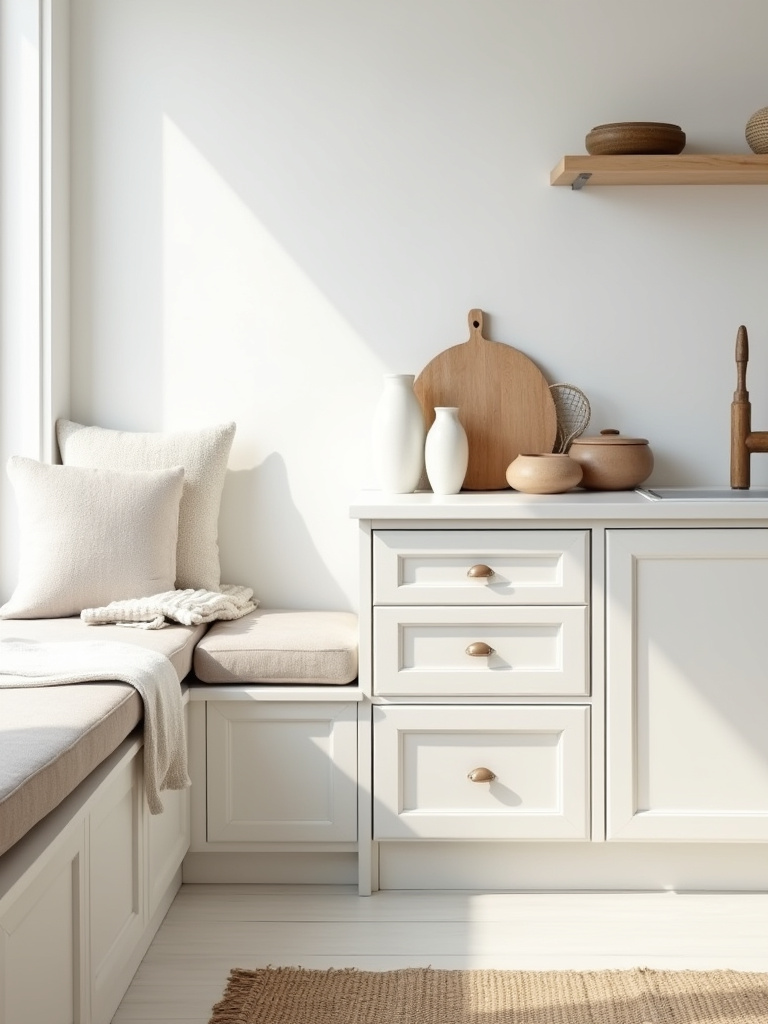
These layers create a rich sensory experience. I love using hand-thrown pottery—like the beautiful blue-and-white patterns of Bolesławiec from Poland—for utensil crocks or vases. The slight imperfections and the feel of the glaze provide a tactile counterpoint to the smooth cabinets. It’s about engaging more than just your sense of sight. It’s about creating a room that feels as good as it looks.
Don’t underestimate the power of the small details, especially the ones you touch every day.
14. Elevate Your Design with Statement Hardware and Fixtures
Hardware is the jewelry of your kitchen. In a white space, it has an even bigger impact because there’s less visual competition. This is a place where a small investment can completely change the character of the room. Think of the difference between simple chrome knobs and hefty, unlacquered brass pulls that will develop a beautiful patina over time. Or the industrial feel of matte black handles versus the delicate elegance of polished nickel.
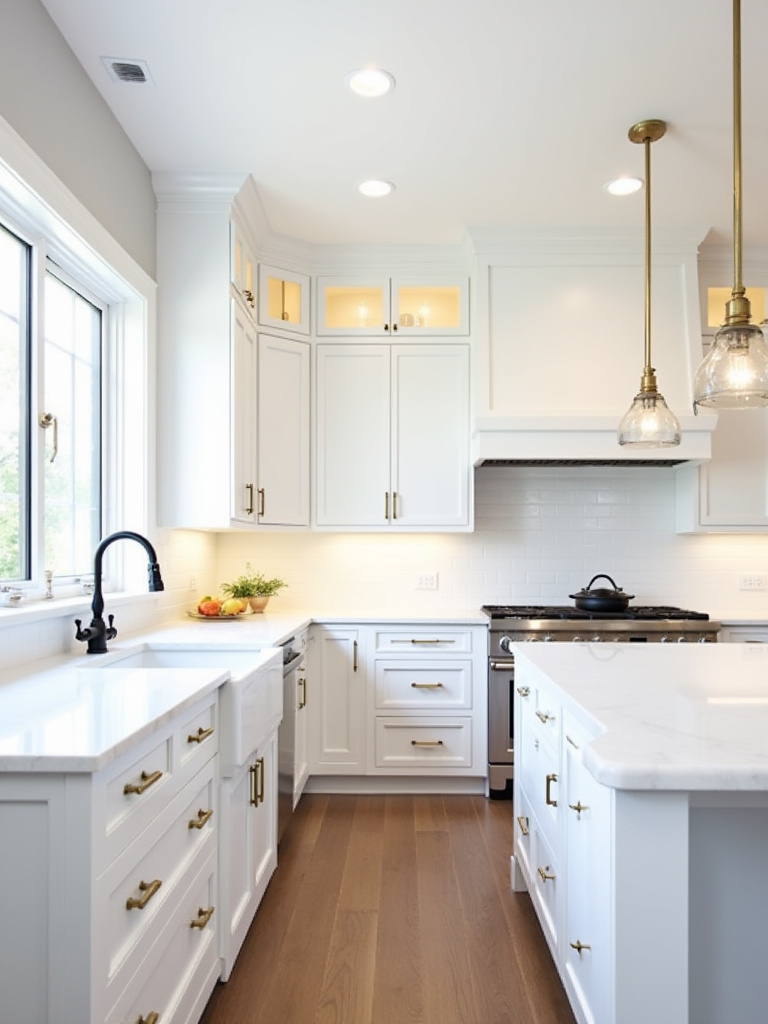
Your faucet is another key piece of jewelry. A gracefully arching gooseneck faucet or a modern, sculptural piece can act as a stunning focal point for your sink area. I advise clients to choose a metal finish that feels authentic to their chosen aesthetic. This creates a cohesive thread that ties the whole room together, making it feel polished and intentional.
And now for the grandest piece of jewelry in the room.
15. Design a Captivating Backsplash that Acts as a Focal Point
The backsplash is your opportunity to be an artist. On the quiet canvas of a white kitchen, the backsplash can be a masterpiece. It can introduce color, pattern, and most importantly, a powerful dose of personality. You can go for a full-height slab of marble with dramatic veining, creating a seamless and luxurious statement. Or you could choose handmade tiles where no two are exactly alike, adding an artisan touch.
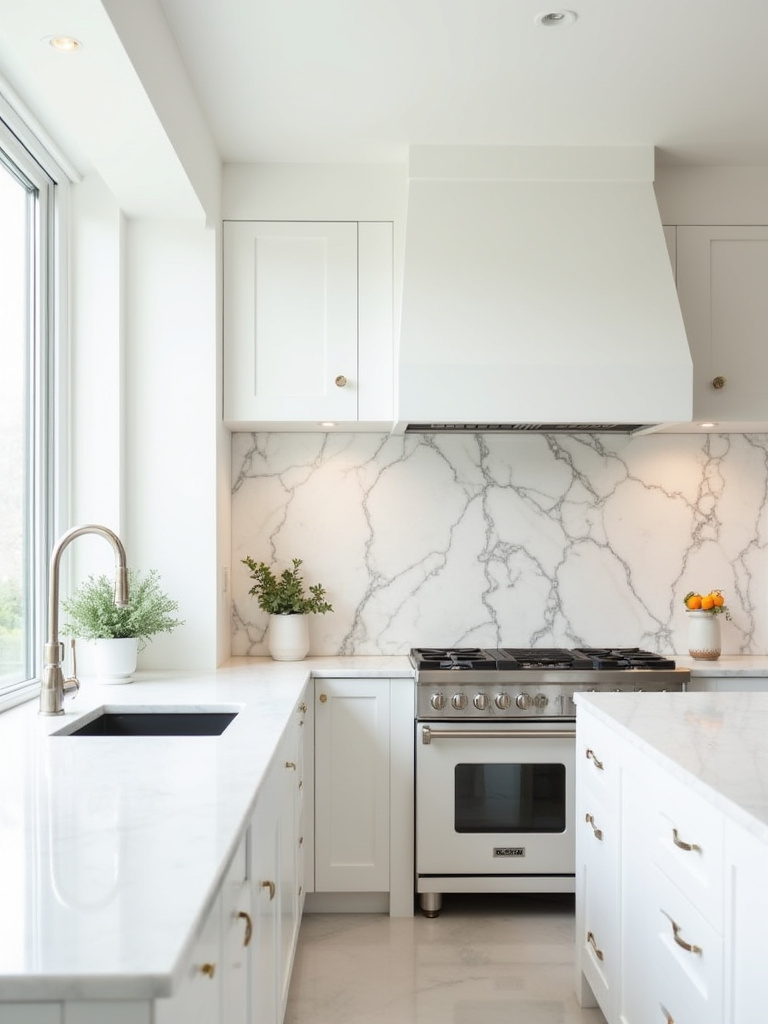
I once worked on a project where the client wanted to honor her Chinese heritage. We sourced incredible celadon green fish-scale tiles for the backsplash behind her range. Against the soft white of the cabinets, it was breathtaking. It was a clear focal point that was both deeply personal and unbelievably chic. The key is to see the backsplash not as a practical necessity to protect your walls, but as the soul of your design.
With the big statements made, we can zoom in on the finishing touches.
Styling & Enhancements: Elevating the White Canvas (Part 2)
These are the final, personal layers that bring a room to life. They are the easiest to change, allowing your kitchen to evolve with you over time. They are the difference between a house in a magazine and a home you truly live in.
16. Incorporate Greenery and Art for a Touch of Life and Personality
Nothing breathes life into a white kitchen like plants and art. Greenery introduces a vibrant, living element that instantly softens the hard lines of a kitchen. A simple pot of herbs on the windowsill, a trailing pothos on top of the cabinets, or a dramatic fiddle-leaf fig in a corner all add organic beauty. In many Eastern cultures, bringing nature indoors is essential for good energy.
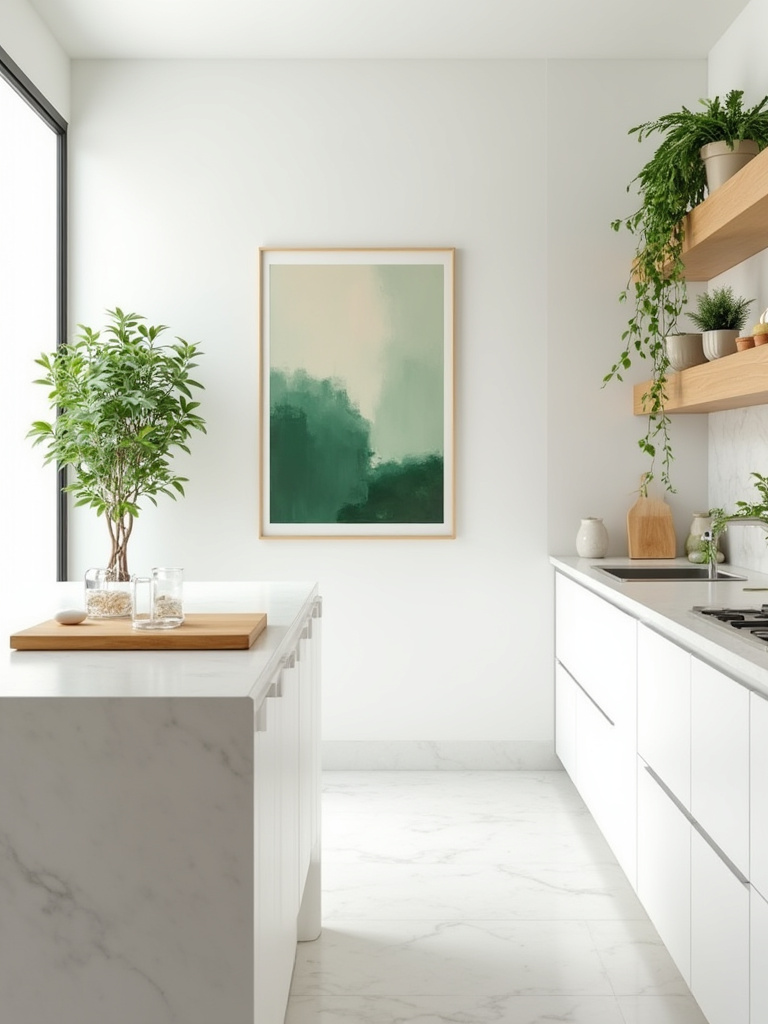
Art is where you tell your most personal stories. Don’t just buy “kitchen art.” Hang something meaningful. A vintage map of your ancestral town, a framed recipe from your grandmother, a child’s drawing, or a beautiful abstract canvas. This is what transforms a kitchen from a generic design into your kitchen. On a white wall, even the smallest piece of art has a powerful voice.
Next, let’s create a small ritual space within the kitchen.
17. Create a Dedicated Beverage or Coffee Station for Convenience and Charm
A dedicated spot for making your morning coffee or evening tea can feel like an incredible luxury, but it’s actually a very practical use of space. It corrals all the related items—the machine, mugs, sugar, pods—into one organized zone, which frees up your main counters for cooking. But more than that, it creates a charming little moment, a ritual.
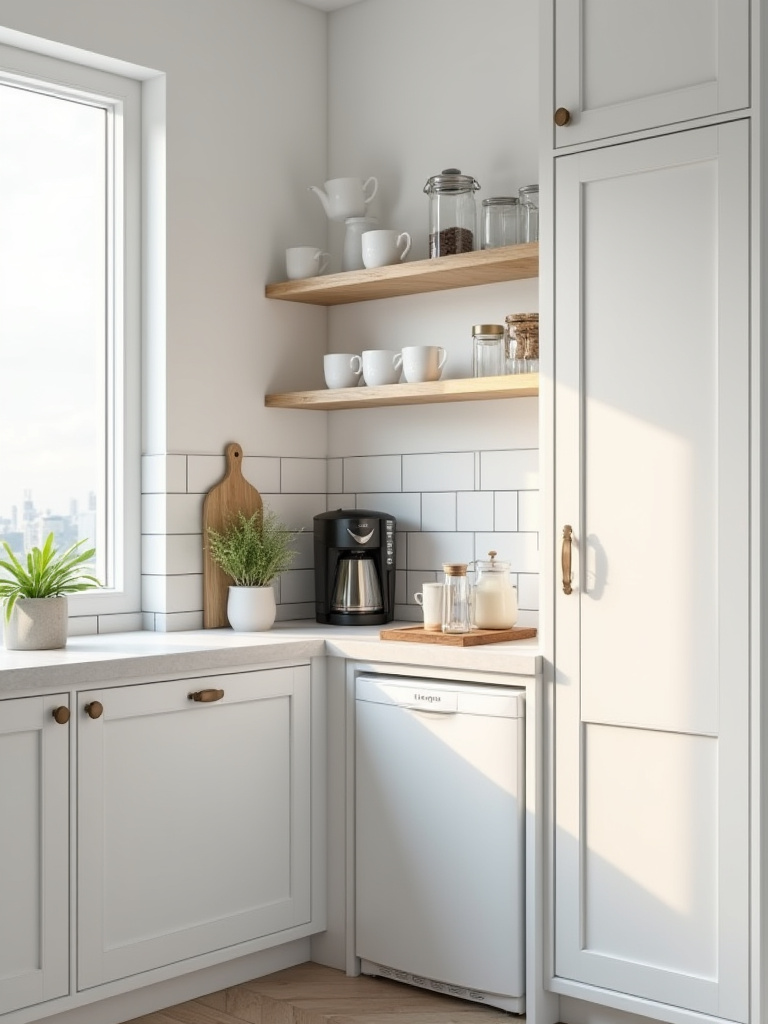
I love designing these nooks. We can use a different backsplash tile to define the area, add some open shelving for beautiful mugs, or tuck a small beverage fridge underneath. For a client who was an avid tea collector, we created a station with canisters for her loose-leaf teas, a special kettle, and her collection of antique Yixing teapots. It became a beautiful display that was also supremely functional—a little sanctuary within the larger space.
With the kitchen designed and styled, we must talk about keeping it beautiful.
Advanced Touches & Maintaining the Pristine Look (Part 1)
This is about future-proofing your dream kitchen. It’s about integrating technology thoughtfully and establishing habits that will protect your investment and keep your beautiful white space looking pristine for years to come.
18. Integrate Smart Home Technology for Enhanced Convenience and Efficiency
Smart technology shouldn’t feel cold or complicated. At its best, it should bring a sense of ease and effortlessness to your daily life. In the kitchen, this can mean a faucet that turns on with a touch when your hands are full, under-cabinet lighting that brightens with a voice command, or a refrigerator that lets you peek inside from your phone at the grocery store.
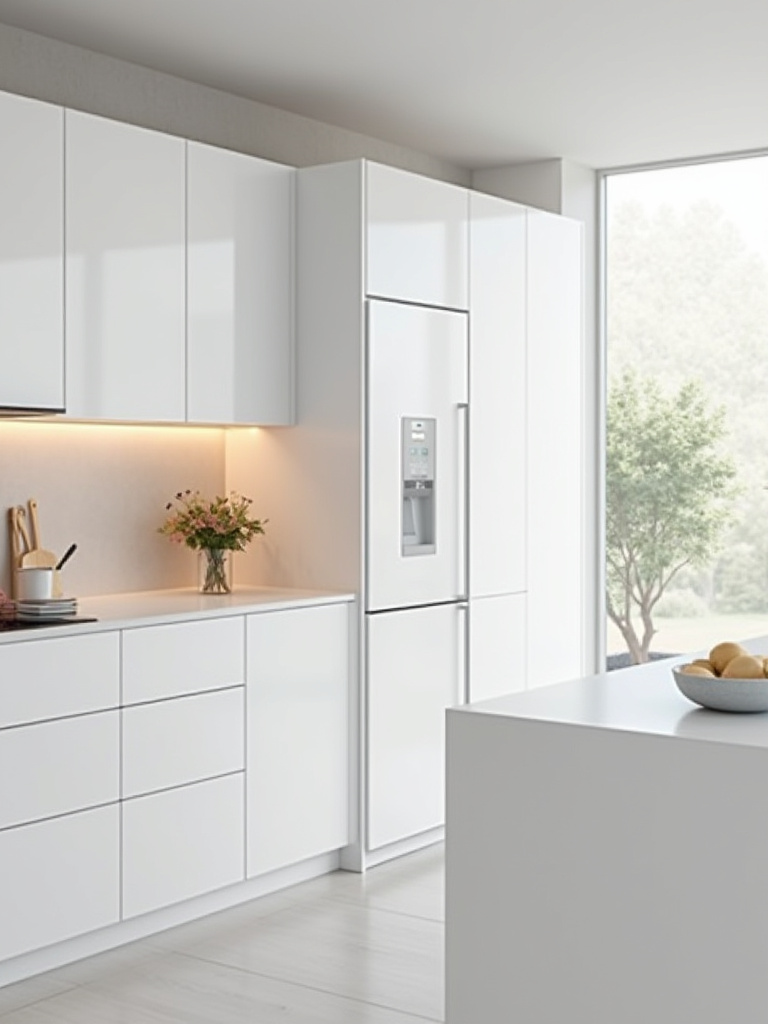
The key is to integrate it seamlessly, so it enhances the serene feeling of your white kitchen rather than cluttering it with gadgets and screens. A discreet smart hub, outlets with built-in USB ports, and appliances you can control from an app all contribute to a more streamlined and efficient life. This isn’t about creating a futuristic, sterile lab; it’s about using technology to support a more peaceful and organized home.
Peace and organization are also the goals of our next point.
19. Implement an Effective Cleaning Regimen to Keep White Surfaces Spotless
Let’s bust this myth right now: white kitchens are not harder to keep clean. They just show you the dirt sooner, which is actually a good thing! It encourages you to wipe up spills immediately, which is the key to preventing stains on any surface, no matter the color. The secret isn’t aggressive scrubbing; it’s consistent, gentle care.
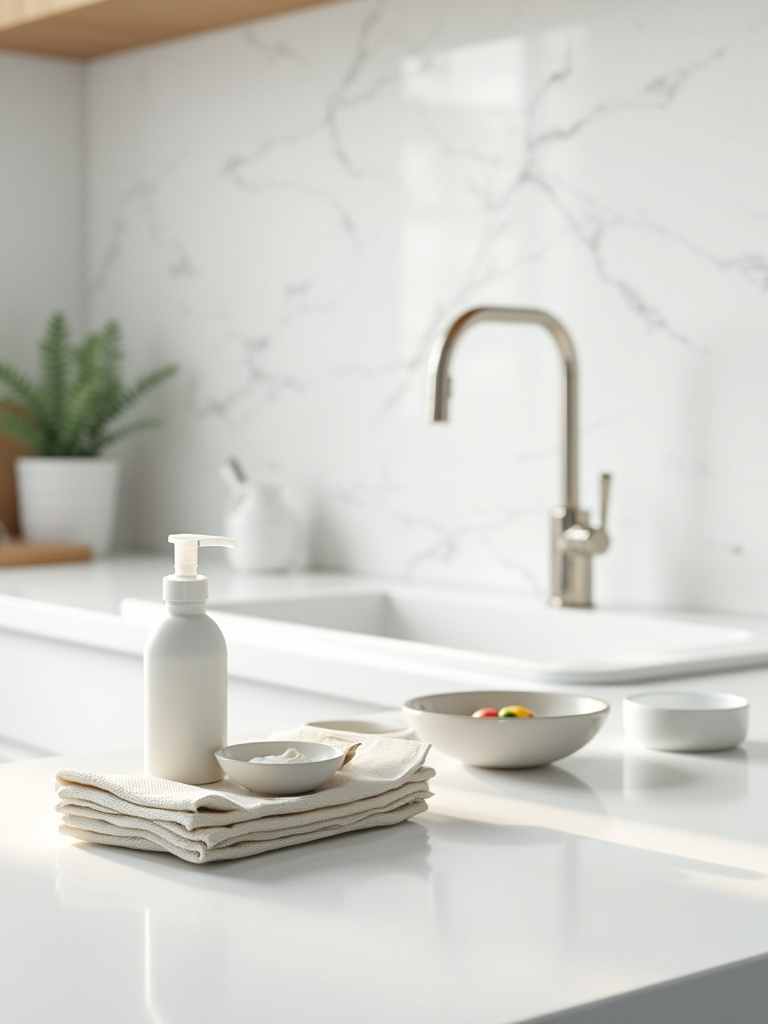
I tell all my clients the same thing: adopt a “clean as you go” philosophy. A soft microfiber cloth and a gentle, pH-neutral cleaner are your best friends. Wipe down counters and cabinet fronts after you cook. It takes two minutes, and it prevents the dreaded buildup of grease and grime. Think of it as a small act of respect for the beautiful space you’ve created—a daily ritual of care.
Another key to preventing grime is having the right tools for the job.
20. Strategically Introduce Color Pops for Dynamic Visual Impact
While your primary palette is white and your grounding elements are texture-rich, a few strategic pops of color can add an incredible layer of energy and joy. The beauty of a white kitchen is that it allows even the smallest amount of color to have a huge impact. This is where you can be playful and non-committal.
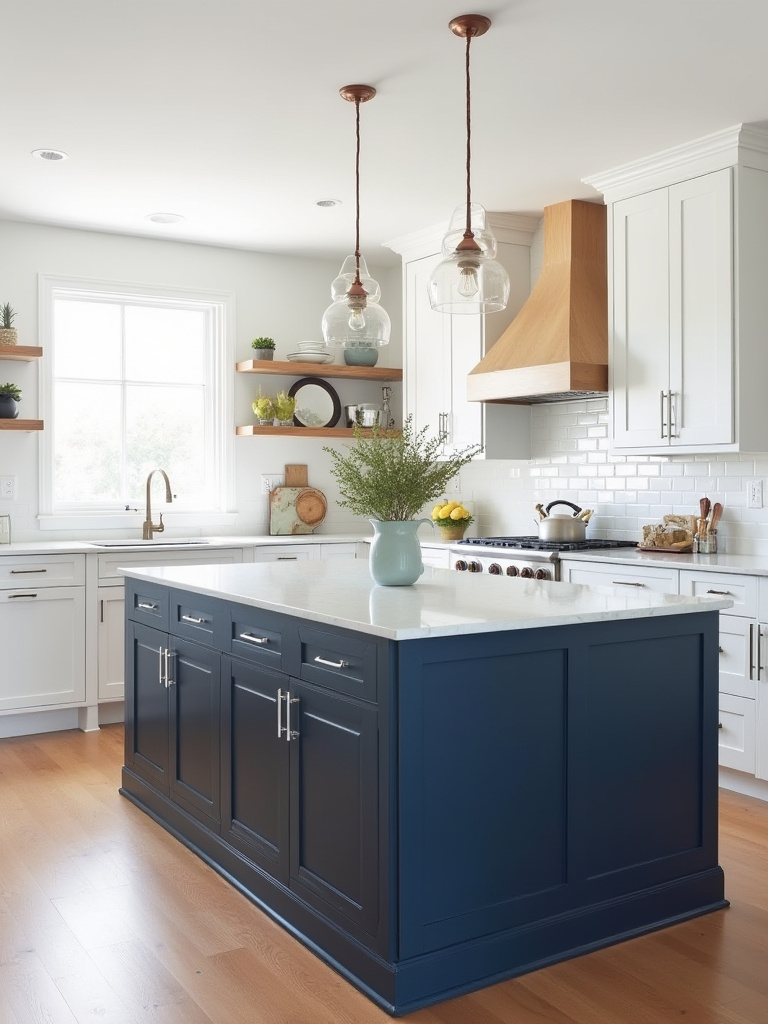
Think about a bright red stand mixer, a set of cobalt blue bar stools, or a vibrant floral arrangement on the island. These are things that are easy to change with the seasons or your mood. It’s like adding a beautiful silk scarf to a classic outfit. I have a collection of Polish pottery, known for its bold patterns and colors, that I rotate on my open shelves. It adds a splash of personal history and cheerfulness against the calm backdrop.
To keep that backdrop pristine, we need to talk about air quality.
21. Optimize Ventilation Systems to Prevent Stains and Preserve Air Quality
This is the least glamorous part of kitchen design, but it might be the most important for the longevity of a white kitchen. A powerful, efficient ventilation hood is your number one defense against the invisible enemy: grease. Airborne grease particles will settle on every surface, and over time they create a sticky, yellow film that is a nightmare to clean and will ruin your white finish.
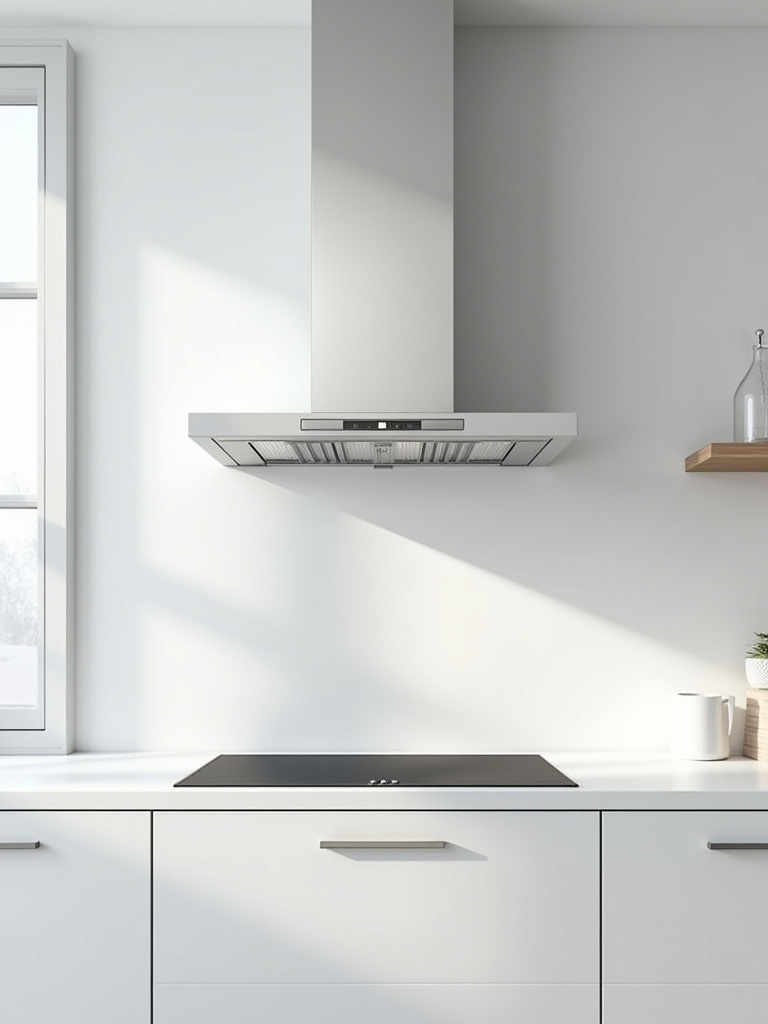
Don’t let anyone sell you a cheap, recirculating vent that just blows air around. You need a ducted system that pulls the steam, smoke, and grease particles completely out of your home. It’s a critical investment that protects your cabinets, your backsplash, and your lungs. Run it every single time you cook—even if you’re just boiling water. It makes a world of difference.
Finally, let’s look to the future.
Advanced Touches & Maintaining the Pristine Look (Part 2)
A dream kitchen isn’t just for today; it’s a long-term investment in your home and your happiness. This final touch is about planning for a lifetime of beauty and function.
22. Plan for Timeless Updates and Maintain Material Integrity Over Time
The beauty of a classic white kitchen is its incredible longevity. It doesn’t fall prey to fleeting trends. To ensure this, choose timeless core elements: classic cabinet profiles like a Shaker or a simple slab door, durable countertops, and a functional layout. These are the bones of your kitchen.
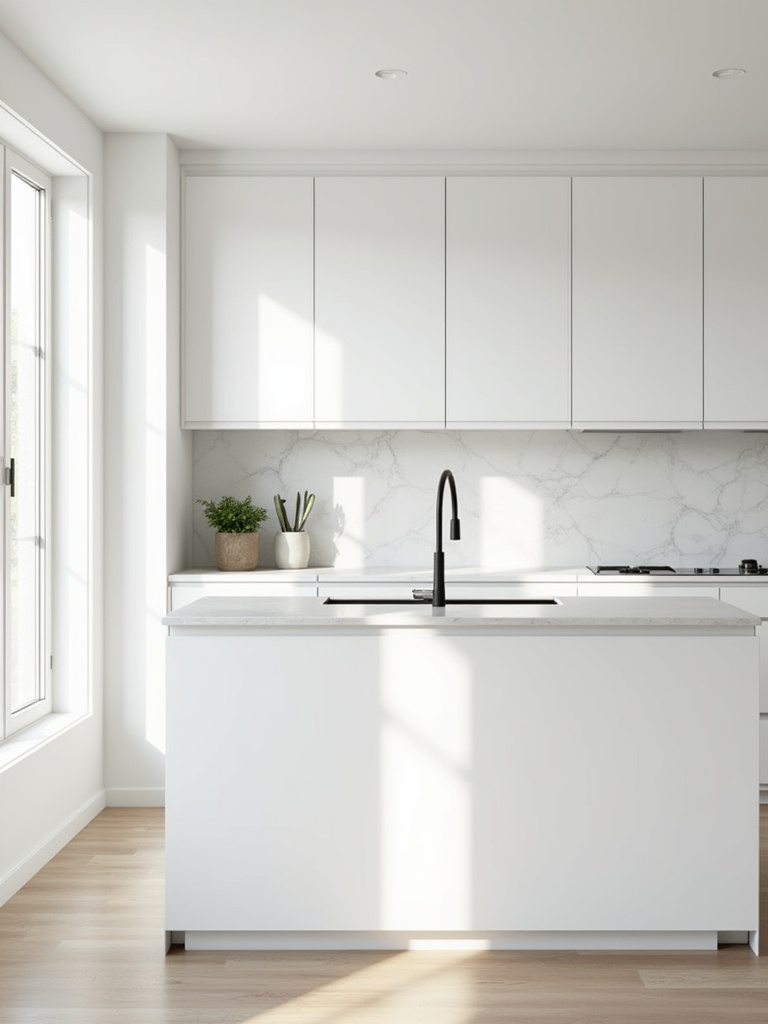
From there, you can easily update the look over the years by changing the “jewelry” we talked about—the hardware, the light fixtures, the paint color on an island, the bar stools. This is much less expensive and disruptive than a full renovation. Combine this design flexibility with a consistent maintenance routine—resealing stone countertops as needed, touching up paint nicks immediately, deep cleaning annually—and you’ll have a kitchen that looks and feels brilliant for decades. You’re not just designing a room; you’re becoming the steward of a beautiful, enduring space.
Conclusion
So, you see, the idea of a white kitchen as “safe” or “boring” completely misses the point. A white kitchen is a brave choice. It’s a declaration that you value clarity, light, and harmony. It’s an act of curating a space that is less about the color on the walls and more about the life and stories that will unfold within them. It becomes a canvas for your heritage, a backdrop for your daily rituals, and a celebration of your personal journey.
Your home should be your sanctuary and your storybook. The kitchen, its heart, is the perfect place to start telling that story. Don’t be afraid of the blank canvas. Embrace it. See it as an invitation to layer in the textures, memories, and details that are uniquely yours. Let it be the quiet, luminous stage where the beautiful, messy, wonderful drama of your life can play out. Your dream kitchen isn’t just out there in a magazine; it’s waiting to be created by you, for you.
